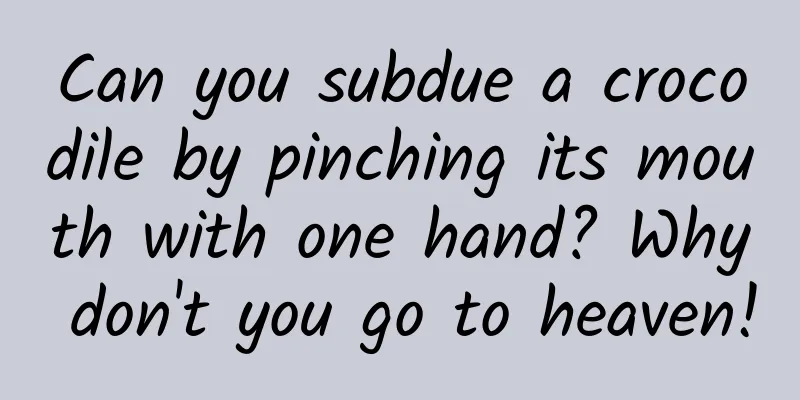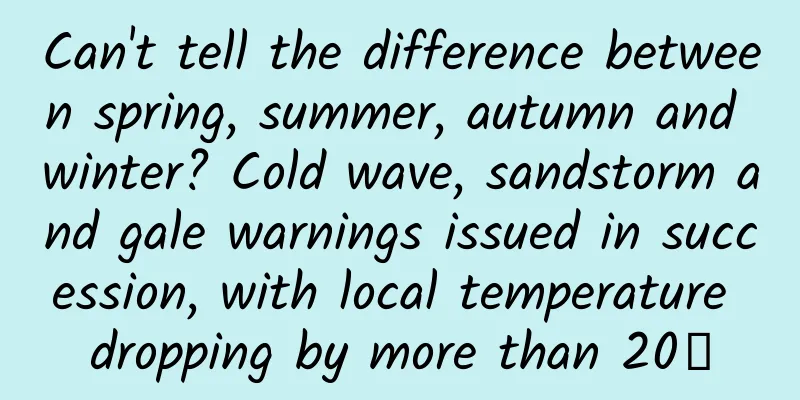Can you subdue a crocodile by pinching its mouth with one hand? Why don't you go to heaven!

|
What? Last time there was a news report about a crocodile drowning in the water, do you think that crocodiles are "softies" that can be manipulated at will? You can also subdue a crocodile by pinching its mouth with one hand, so why don't you just go to heaven? Recently, a piece of "knowledge" in a "popular science book" was exposed on Weibo that was extremely insulting to IQ... Does this scene and description look familiar to hardcore science enthusiasts? In 2003, in the BBC documentary Sea Monsters–A Walking with Dinosaurs Trilogy (Chinese title: Walking with Sea Monsters), produced using computer imaging technology, wildlife biologist Nigel Marvin used this method to teach the audience how to subdue the Dinosaurs in the Triassic Ocean... Nigel Marvin's Brave Conquest of Nothodon in the Triassic Ocean I can only say that the knowledge point presented in this popular science book not only insults the readers' IQ, but also insults crocodiles themselves. We must know that the crocodiles' way of survival is not just by "biting" as people know it. In fact, as early as 1986, Michael Alan Taylor, a scholar at the Leicestershire Museum in the UK, made a relatively comprehensive summary of the hunting behaviors of aquatic quadrupeds, represented by crocodiles. The author summarized it as the "three-word formula" of crocodiles: ●“Bite” Tips They use their toothy, "pincer"-like jaws to bite their prey and swallow it whole. This method is suitable for dealing with smaller prey such as snails, fish, turtles, frogs, etc. There is no need to explain the bite force of crocodiles. Generally, they can easily crack turtle shells and bones. An American alligator preys on a bullfrog in Woodruff Lake, USA. (Photo by Andrea Westmoreland) An American alligator eats a freshwater turtle. (Photo by Whoisjohngalt) ● "Shake" If the crocodile faces a larger prey, they will bite the prey, then drag it to the surface of the water, shake it left and right on the water, and use their strong muscle power to shake the prey into smaller, easier-to-handle "pieces". This method is also called "shake feeding". Prey of the size of gazelles are more suitable for this method. A Nile crocodile shakes a gazelle frantically, breaking it in half (Photo by Jeffrey Wu) ● "Twist" trick If the crocodile is facing a prey that is too large, it will use the well-known "death roll" to tear the flesh off the large prey with the twisting force of the body and the jaws. Crocodiles often use this "twist feeding" when dealing with large prey such as wildebeests and zebras. Zoo keepers test a crocodile's death roll (Credit: Australian Reptile Park) One thing we can be sure of is that the force of a crocodile's mouth opening is indeed much smaller than its bite force. After all, we often observe that when a crocodile is caught accidentally, several people work together to control it and wrap a rubber band around its mouth, it is indeed difficult for the crocodile to break free. People are using rubber bands to tie up the crocodile's mouth (Source: Snail Loves Fishing) Such operations generally require the cooperation of multiple people, assisted by tools such as ropes and iron rods, to reduce the risk to a certain extent, but there are still major safety hazards. Therefore, the popular science book says that the old man can pinch the crocodile's mouth with one hand, which is still a fantasy. Even if he pinches the crocodile's mouth, the crocodile's powerful "shaking force" will break the gazelle in half. How difficult is it to break free from the old man's hand? Is the old man's hand still needed? It's too much of a waste for the old man... In addition, you won’t know until you read it. It’s really shocking. There are too many flaws in this popular science book! First, regarding the habitat of the saltwater crocodile, the "junction of seawater and freshwater along the Indian Ocean coast" is very problematic. The saltwater crocodile is not limited to the "Indian Ocean coast", the vast "Pacific coast" is also an important distribution area. From southwestern India and eastern Sri Lanka, through southeastern Asia, the Philippines, the Indonesian archipelago, and northern Australia to the Solomon Islands. They are even able to cross large areas of open ocean, and individuals of saltwater crocodiles have been found on remote islands in the Indian Ocean and western Pacific, such as Fiji. In Australia, saltwater crocodiles are found from Broome in northwest Western Australia to Gladstone in southeast Queensland, and are also found on a number of islands off the coast of Queensland, which are more than 90 kilometers from the mainland at their closest point. Geographical distribution map of saltwater crocodiles (Source: Australian Museum) In addition, the habitat of the saltwater crocodile needs to take into account factors such as season and territory. The "junction of seawater and freshwater" mentioned in the book cannot accurately summarize its habitat. Saltwater crocodiles usually spend the tropical rainy season in freshwater areas such as swamps, rivers, and oxbow lakes, and move downstream to the river mouths during the dry season. Saltwater crocodiles will fiercely compete for territory with other saltwater crocodiles, and the dominant adult male saltwater crocodiles will occupy the most "habitable" freshwater areas. Saltwater crocodiles live comfortably in the Ord River on the Kimberley Plateau in Australia (drawn by Brinkley Davies). This place has become an ideal place for local "warriors" to "watch" saltwater crocodiles. Among the trees near the boat ramp on the bank of the Ord River is the "Mambee Island Camping Area". Secondly, regarding the length of the saltwater crocodile, "up to 6 meters" is definitely inaccurate. In the last popular science article about crocodiles, the saltwater crocodile star "Luo Long" was introduced. It was 6.17 meters long and weighed more than 1,000 kilograms. It is the largest saltwater crocodile ever measured in detail. Therefore, the "more than 6 meters" in the text of this page is reliable. The editor of this book is too careless and should be laid off! The Losaurus skeleton preserved in the National Museum of the Philippines (Photo by Julan Shirwod Nueva) In the past few decades, there have been some larger and more terrifying body size data of saltwater crocodiles that cannot be fully confirmed. For example, Peter Taylor measured a saltwater crocodile skull specimen collected in Cambodia at the French National Museum of Natural History in July 2003. The skull specimen was about 76 centimeters long, and the length of the complete individual was unknown. However, based on the ratio of the saltwater crocodile's skull to its total length, its length is likely to be in the range of 7 meters. In June 2006, at the CSG conference held in Montreal, Canada, this saltwater crocodile skull specimen won a grand prize and was hailed as the "King of Cambodia". This saltwater crocodile was killed in Cambodia around the early 19th century. Peter Taylor and the "King of Cambodia" (Source: Dragon Claw Honghuang) Oh my God, there are so many questions in just one page. I really want to see the whole book. However, this also urges me to take this as a negative example and be more serious in popularizing science in the future! Crocodile: Is that the end? Don't let me appear in such insulting books again. I'm going to anonymize myself... References: Encyclopædia Britannica. "Crocodile". Retrieved 29 April 2013. MICHAEL ALAN TAYLOR. How tetrapods feed in water: a functional analysis by paradigm[J]. Zoological Journal of the Linnean Society,1987,91(2): Webb, GJW; Manolis, C.; Brien, ML; Balaguera-Reina, SA & Isberg, S. (2021). "Crocodylus porosus". IUCN Red List of Threatened Species. 2021: e.T5668A3047556. doi:10.2305/IUCN.UK.2021-2.RLTS.T5668A3047556.en. Retrieved 20 November 2021. Ross, CA; Garnett, S., eds. (1989). Crocodiles and Alligators. Checkmark Books. Lolong" holds world record as largest croc in the world". Biodiversity Management Bureau. 17 November 2011. Retrieved 8 January 2016. Britton, Adam (12 November 2011). "Accurate length measurement for Lolong". Croc Blog. Retrieved 8 January 2016. NatGeo team confirms Lolong the croc is world's longest". GMA News. 9 November 2011. Retrieved 23 June 2012. Philippine town claims world's largest crocodile title". The Telegraph. 9 November 2011. Archived from the original on 10 November 2011. Retrieved 23 June 2012. Greer, AE (1974). "On the Maximum Total Length of the Salt-Water Crocodile (Crocodylus porosus)". Journal of Herpetology. 8 (4): 381–384. END Author: Archaeology Xueqi, Master of History, Wuhan University, majoring in Shang and Zhou Dynasty archaeology Tadpole Musical Notation original article, please indicate the source when reprinting Editor/Heart and Paper |
<<: Seahorse dad can "give birth"
>>: Can a rice cooker be used to boil water?
Recommend
So the question is: Among WeChat, Weibo, and Tieba, which fan economy platform is the best?
Double Eleven has not yet arrived, but the "...
Eat a little of it every day to nourish your brain, protect your eyes and skin! You can do it in just 2 steps!
As early as the 1940s, people found that the Eski...
Why don't animals have cavities even if they don't brush their teeth? Why don't teeth get pulled crooked by braces?
Before reading this article, please shut up. Let ...
The bookmark of the stratum - the "golden nail"
The bookmark of the stratum - the "golden na...
Mercedes-Benz's first pure electric car rendering is full of technology
At this year's Paris Motor Show, Mercedes-Ben...
Lots of useful information! How can interaction designers improve the controllability of products?
Interaction designers pursue the goal of providin...
A must-learn for Pinduoduo merchants to open a store, a literacy course for beginners with zero basics (58 video courses)
A must-learn for Pinduoduo merchants to open a st...
Yuanfudao Children's Programming Course L1+L2
LEVEL1 Course Content Introduction Based on face ...
Marketing node reminder in January 2018 [Dry goods collection]
The long 2017 is finally over, and we are about t...
Analyze the user life cycle and improve app engagement
When your app has acquired a certain number of us...
Would you dare to buy a car that depreciates by more than 600,000 yuan in three years?
The value retention rate has always been an impor...
In the face of the great test of the epidemic, how can educational institutions focus on online marketing and promotion?
The sudden outbreak of the pneumonia has brought ...
The history of the hot money war in China: Huge profits in the top hot money battlefield, A-share hot money biography series PDF
[Hunan Tough Guy] History of the Hot Money War in...
What are the three most feared enemies of mosquitoes? Teach you a trick to never be bitten by mosquitoes!
Mosquitoes are a common insect in summer. They mo...
Event planning and promotion: a universal event planning solution!
There is actually no shortcut to planning an even...
![[Smart Farmers] New technology helps microorganisms settle in water](/upload/images/67f224415f38f.webp)








